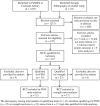Muscular responses to testosterone replacement vary by administration route: a systematic review and meta-analysis
- PMID: 29542875
- PMCID: PMC5989848
- DOI: 10.1002/jcsm.12291
Muscular responses to testosterone replacement vary by administration route: a systematic review and meta-analysis
Abstract
Background: Inconsistent fat-free mass (FFM) and muscle strength responses have been reported in randomized clinical trials (RCTs) administering testosterone replacement therapy (TRT) to middle-aged and older men. Our objective was to conduct a meta-analysis to determine whether TRT improves FFM and muscle strength in middle-aged and older men and whether the muscular responses vary by TRT administration route.
Methods: Systematic literature searches of MEDLINE/PubMed and the Cochrane Library were conducted from inception through 31 March 2017 to identify double-blind RCTs that compared intramuscular or transdermal TRT vs. placebo and that reported assessments of FFM or upper-extremity or lower-extremity strength. Studies were identified, and data were extracted and validated by three investigators, with disagreement resolved by consensus. Using a random effects model, individual effect sizes (ESs) were determined from 31 RCTs reporting FFM (sample size: n = 1213 TRT, n = 1168 placebo) and 17 reporting upper-extremity or lower-extremity strength (n = 2572 TRT, n = 2523 placebo). Heterogeneity was examined, and sensitivity analyses were performed.
Results: When administration routes were collectively assessed, TRT was associated with increases in FFM [ES = 1.20 ± 0.15 (95% CI: 0.91, 1.49)], total body strength [ES = 0.90 ± 0.12 (0.67, 1.14)], lower-extremity strength [ES = 0.77 ± 0.16 (0.45, 1.08)], and upper-extremity strength [ES = 1.13 ± 0.18 (0.78, 1.47)] (P < 0.001 for all). When administration routes were evaluated separately, the ES magnitudes were larger and the per cent changes were 3-5 times greater for intramuscular TRT than for transdermal formulations vs. respective placebos, for all outcomes evaluated. Specifically, intramuscular TRT was associated with a 5.7% increase in FFM [ES = 1.49 ± 0.18 (1.13, 1.84)] and 10-13% increases in total body strength [ES = 1.39 ± 0.12 (1.15, 1.63)], lower-extremity strength [ES = 1.39 ± 0.17 (1.07, 1.72)], and upper-extremity strength [ES = 1.37 ± 0.17 (1.03, 1.70)] (P < 0.001 for all). In comparison, transdermal TRT was associated with only a 1.7% increase in FFM [ES = 0.98 ± 0.21 (0.58, 1.39)] and only 2-5% increases in total body [ES = 0.55 ± 0.17 (0.22, 0.88)] and upper-extremity strength [ES = 0.97 ± 0.24 (0.50, 1.45)] (P < 0.001). Interestingly, transdermal TRT produced no change in lower-extremity strength vs. placebo [ES = 0.26 ± 0.23 (-0.19, 0.70), P = 0.26]. Subanalyses of RCTs limiting enrolment to men ≥60 years of age produced similar results.
Conclusions: Intramuscular TRT is more effective than transdermal formulations at increasing LBM and improving muscle strength in middle-aged and older men, particularly in the lower extremities.
Keywords: Ageing; Androgen; Fat-free mass; Lean mass; Muscle; Musculoskeletal; Strength.
© 2018 The Authors. Journal of Cachexia, Sarcopenia and Muscle published by John Wiley & Sons Ltd on behalf of the Society on Sarcopenia, Cachexia and Wasting Disorders.
Figures







Similar articles
-
Growth hormone and sex steroid administration in healthy aged women and men: a randomized controlled trial.JAMA. 2002 Nov 13;288(18):2282-92. doi: 10.1001/jama.288.18.2282. JAMA. 2002. PMID: 12425705 Clinical Trial.
-
Effects of Testosterone Replacement Therapy on Muscle Strength in Older Men with Low to Low-Normal Testosterone Levels: A Systematic Review and Meta-Analysis.Gerontology. 2023;69(10):1157-1166. doi: 10.1159/000532062. Epub 2023 Jul 26. Gerontology. 2023. PMID: 37494893
-
Mitochondria, glycogen, and lipid droplets in skeletal muscle during testosterone treatment and strength training: a randomized, double-blinded, placebo-controlled trial.Andrology. 2018 Jul;6(4):547-555. doi: 10.1111/andr.12492. Epub 2018 Apr 15. Andrology. 2018. PMID: 29656500 Clinical Trial.
-
Androgen treatment and muscle strength in elderly men: A meta-analysis.J Am Geriatr Soc. 2006 Nov;54(11):1666-73. doi: 10.1111/j.1532-5415.2006.00938.x. J Am Geriatr Soc. 2006. PMID: 17087692 Free PMC article.
-
Testosterone Replacement Therapy and Mortality in Older Men.Drug Saf. 2016 Feb;39(2):117-30. doi: 10.1007/s40264-015-0348-y. Drug Saf. 2016. PMID: 26482385 Review.
Cited by
-
Anabolic-Androgenic Steroids and Exercise Training: Breaking the Myths and Dealing With Better Outcome in Sarcopenia.Front Physiol. 2022 Mar 17;13:838526. doi: 10.3389/fphys.2022.838526. eCollection 2022. Front Physiol. 2022. PMID: 35370776 Free PMC article. Review.
-
Evaluating Sex Steroid Hormone Neuroprotection in Spinal Cord Injury in Animal Models: Is It Promising in the Clinic?Biomedicines. 2024 Jul 4;12(7):1478. doi: 10.3390/biomedicines12071478. Biomedicines. 2024. PMID: 39062051 Free PMC article. Review.
-
Bone in heart failure.J Cachexia Sarcopenia Muscle. 2020 Apr;11(2):381-393. doi: 10.1002/jcsm.12516. Epub 2020 Feb 22. J Cachexia Sarcopenia Muscle. 2020. PMID: 32087616 Free PMC article. Review.
-
Correlation Analysis between Hypogonadal Symptoms and Changes in Body Composition and Physical Fitness after Testosterone Treatment in Men with Testosterone Deficiency.World J Mens Health. 2024 Jan;42(1):178-187. doi: 10.5534/wjmh.220274. Epub 2023 Apr 19. World J Mens Health. 2024. PMID: 37118963 Free PMC article.
-
The role of the androgen receptor in the pathogenesis of obesity and its utility as a target for obesity treatments.Obes Rev. 2022 Jun;23(6):e13429. doi: 10.1111/obr.13429. Epub 2022 Jan 27. Obes Rev. 2022. PMID: 35083843 Free PMC article. Review.
References
-
- Travison TG, Araujo AB, O'Donnell AB, Kupelian V, McKinlay JB. A population‐level decline in serum testosterone levels in American men. J Clin Endocrinol Metab 2007;92:196–202. - PubMed
-
- van den Beld AW, de Jong FH, Grobbee DE, Pols HA, Lamberts SW. Measures of bioavailable serum testosterone and estradiol and their relationships with muscle strength, bone density, and body composition in elderly men. J Clin Endocrinol Metab 2000;85:3276–3282. - PubMed
-
- Baumgartner RN, Waters DL, Gallagher D, Morley JE, Garry PJ. Predictors of skeletal muscle mass in elderly men and women. Mech Ageing Dev 1999;107:123–136. - PubMed
-
- Spitzer M, Huang G, Basaria S, Travison TG, Bhasin S. Risks and benefits of testosterone therapy in older men. Nat Rev Endocrinol 2013;9:414–424. - PubMed
Publication types
MeSH terms
Substances
Grants and funding
LinkOut - more resources
Full Text Sources
Other Literature Sources

